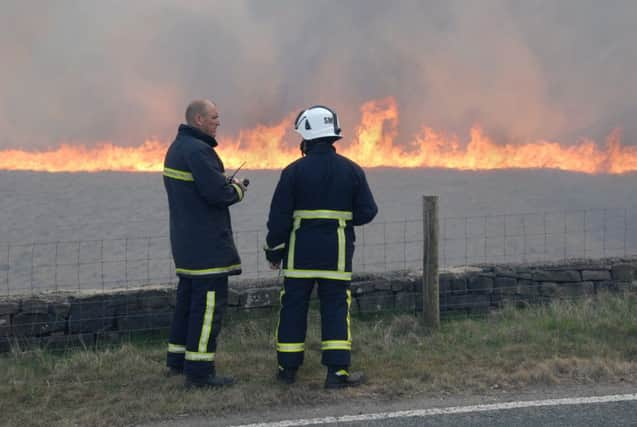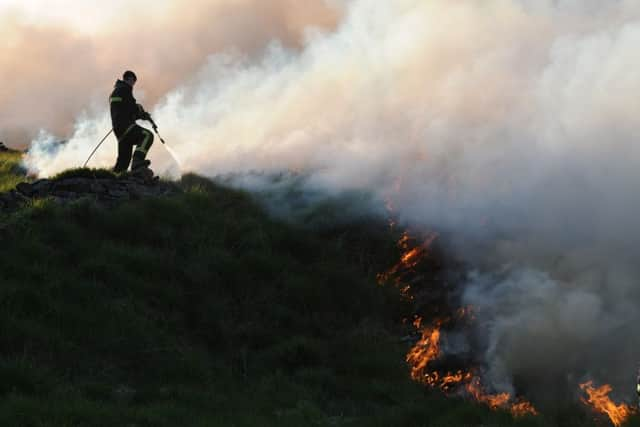Firefighters planning to tackle menace of moorland fires


Given the huge swathes of open moorland there is the risk of fires breaking out and the early springtime presents conditions where dead grassland andheather, exposed to high winds, can quickly dry and become very combustible.
Often a dropped cigarette or carelessly discarded barbecue is all it takes to start a blaze, which depending on the lay of the land and the wind conditions can spread at speed.
Advertisement
Hide AdAdvertisement
Hide AdThe burn season runs from October 1 to April 15 and allows land owners with an appropriate licence to manage their land using burning techniques.


If these fires get out of control they can also present a problem.
Station Manager Nick Watson, who is the WYFRS lead on wildfires, said: “Along with partners we are passionate about protecting the moorland and its wildlife.
“When a large fire does break out, it is also arduous work for firefighters to extinguish it, as they are walking and working on the sometimes unpredictable moorland terrain.
Advertisement
Hide AdAdvertisement
Hide Ad“If the wind catches the fire and the gradient of the land is in its favour, it can spread at a frightening rate and keep burning for a number of days.


“Often night-time is the best time for us to tackle a moorland fire when the ground has become damper and temperatures drop and fortunately we have some excellent equipment to help us do that.
“It’s this time of year that we start to see moorland fires, due to the large quantity of dead grasses and the fact that new growth has not had a chance to ‘green’ yet so there’s little water content.
“However they are preventable and our message to the public is to be vigilant and respect the precious moorland and its habitation.”
Advertisement
Hide AdAdvertisement
Hide AdThere have been 448 recorded incidents involving outdoor/grassland, woodland or crops/heathland or moorland that West Yorkshire crews have attended between January 2011 and the end of 2015.
Firefighters from Todmorden have been planning for the wildfire season since early February this year.
They have been training with other crews from neighbouring Lancashire Fire and Rescue Service at Bacup and Rawtenstall fire stations, to test cross border working and to identify resources each Fire Authority has at their disposal.
The Wildfire Units at Todmorden, Keighley and Holmfirth stations are ready to be deployed anywhere in the brigade, dealing with not only wildfire incidents, but also offering assistance in other places where regular fire engine access is impossible. The units include three bespoke fire appliances that provide the flexibility to be used as a normal fire engine that serves the community, whilst also offering an off-road capability, with four wheel drive.
Advertisement
Hide AdAdvertisement
Hide AdTodmorden also houses the only Argocat all-terrain vehicle in WYFRS, and this is called to any incidents where further infiltration into otherwise inaccessible areas is required.
Fitted with a 500 litre water tank and a fire fogging system, this appliance can be continuously engaged in fire fighting for up to 40 minutes without the need for water replenishment.
A three thousand litre portable dam also provides the capability to store water, which may also be filled via aerial support from a helicopter in remote areas.
One of the newest methods of fire-fighting is the use of powerful back pack blowers, which vastly reduces the number of personnel required to extinguish fires in moorland grasses and shrub heathers.
Advertisement
Hide AdAdvertisement
Hide AdRachel Bairstow, Neighbourhood Policing Team Inspector for Calderdale Valleys, said; “We continue to work closely with our partners to make sure the communities in the district are safe.
“The moor areas around our rural communities can become vulnerable to accidental fires, and there are unfortunately those who will start deliberate fires, putting the public, domestic and wild animals and the moorland at risk.
“Anyone who is found to have started a fire deliberately at a site of special scientific interest could face a fine of up to £20,000.
“We would encourage anyone who sees anything, or anyone acting suspiciously to contact us on 101. In an emergency always call 999.”